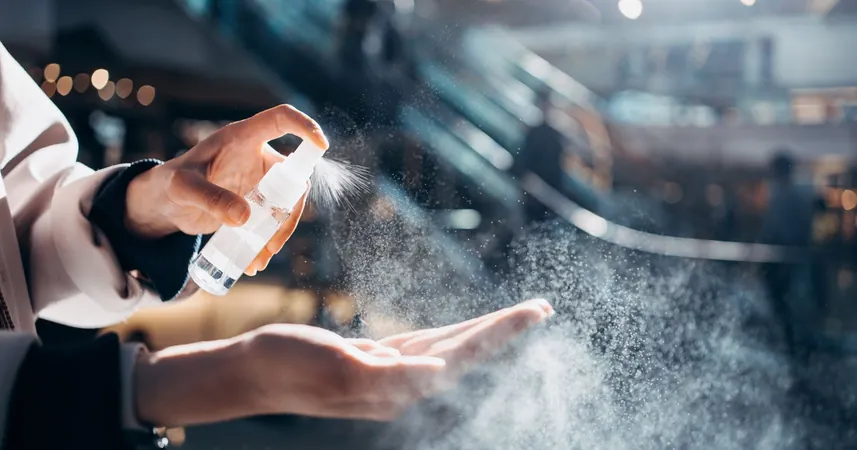
The Hidden Truth About Hand Sanitizers: Do They Really Kill All Germs?
2025-06-03
Author: Ken Lee
The Surprising Limitations of Hand Sanitizers
You might think that a quick squirt of hand sanitizer is all you need to keep germs at bay, especially when you're on the move. But don't be fooled! While many hand sanitizers boast a 99.9% germ-killing effectiveness, they aren't infallible. In fact, certain types of viruses and bacteria can resist their effects and leave you vulnerable to illnesses.
"The 99.9% claim is based on lab tests under ideal conditions," warns Dr. Anthony K. Leung, an infectious disease specialist at Cleveland Clinic. Factors like dirty hands, insufficient sanitizer, and low alcohol concentration can drastically reduce its effectiveness.
How Do Hand Sanitizers Work?
So how do these little bottles of liquid magic actually work? The secret lies in their active ingredients: isopropanol or ethanol. When these alcohols come into contact with the proteins of bacteria or viruses, they cause significant damage that can incapacitate them.
The Germs that Hand Sanitizer Can't Defeat
Unfortunately, not all germs are created equal. Some are tough enough to resist the impact of hand sanitizers. Norovirus, adenovirus, and rhinovirus—culprits behind many common illnesses—lack the outer protective layer that makes them susceptible to alcohol. Additionally, certain bacteria like Clostridium difficile can form protective spores that hand sanitizer struggles to penetrate. Think of spores as a fortress; even if alcohol battles within, it often fails to break through.
Plus, parasites like cryptosporidium have protective shells resembling bomb shelters, making them highly resistant to alcohol sanitizers.
When to Choose Soap Over Sanitizer
Experts unanimously agree: nothing beats good old-fashioned hand washing. Dr. Soniya Gandhi from Cedars-Sinai Medical Center emphasizes that washing your hands with soap and water is the best defense against germs. Make sure to lather and scrub for at least 20 seconds, thoroughly drying your hands afterward to minimize germ transmission.
Maximizing the Effectiveness of Hand Sanitizer
When soap isn’t available, hand sanitizer can be a suitable alternative. Here are some tips to make sure you're maximizing its effectiveness: 1. **Pick the Right Product:** Choose sanitizer with at least 60% alcohol for optimal germ-killing power. 2. **Apply Generously:** Use enough product to keep your hands wet for 15-20 seconds. 3. **Don't Skimp on Coverage:** Rub it into every nook and cranny—palms, backs of hands, and between fingers. 4. **Let It Dry:** Resist the urge to wipe it off; let your hands air dry completely.
Final Thoughts: Stay Safe and Healthy!
Remember, hand sanitizer is not a catch-all solution. Dr. Leung advises washing your hands with soap and water after using the restroom, before meals, or after coming into contact with waste. And always remember: hand sanitizer cannot remove harmful chemicals or work effectively on visibly dirty hands.
In addition to proper hand hygiene, avoid touching your face, regularly clean high-touch surfaces, and refrain from preparing food for others if you're feeling under the weather. Following these simple steps can go a long way in keeping you and your loved ones healthy!


 Brasil (PT)
Brasil (PT)
 Canada (EN)
Canada (EN)
 Chile (ES)
Chile (ES)
 Česko (CS)
Česko (CS)
 대한민국 (KO)
대한민국 (KO)
 España (ES)
España (ES)
 France (FR)
France (FR)
 Hong Kong (EN)
Hong Kong (EN)
 Italia (IT)
Italia (IT)
 日本 (JA)
日本 (JA)
 Magyarország (HU)
Magyarország (HU)
 Norge (NO)
Norge (NO)
 Polska (PL)
Polska (PL)
 Schweiz (DE)
Schweiz (DE)
 Singapore (EN)
Singapore (EN)
 Sverige (SV)
Sverige (SV)
 Suomi (FI)
Suomi (FI)
 Türkiye (TR)
Türkiye (TR)
 الإمارات العربية المتحدة (AR)
الإمارات العربية المتحدة (AR)